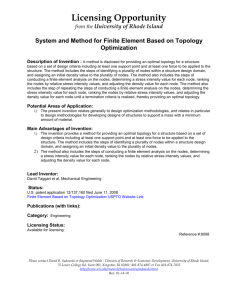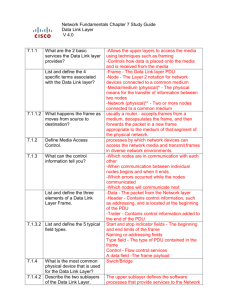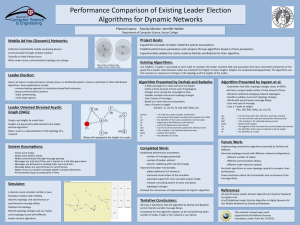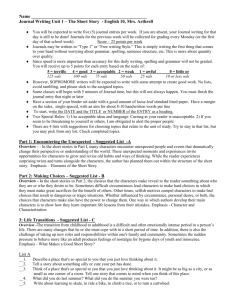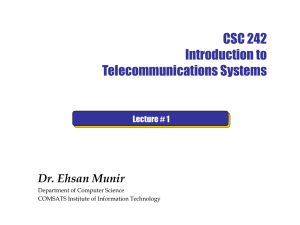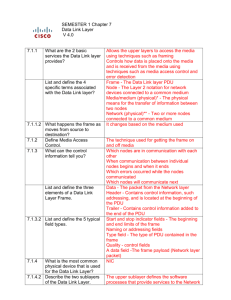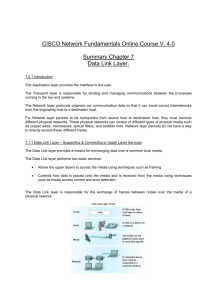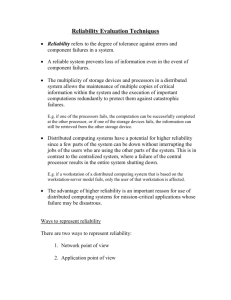A Complex System Overview of Water Supply Networks
advertisement
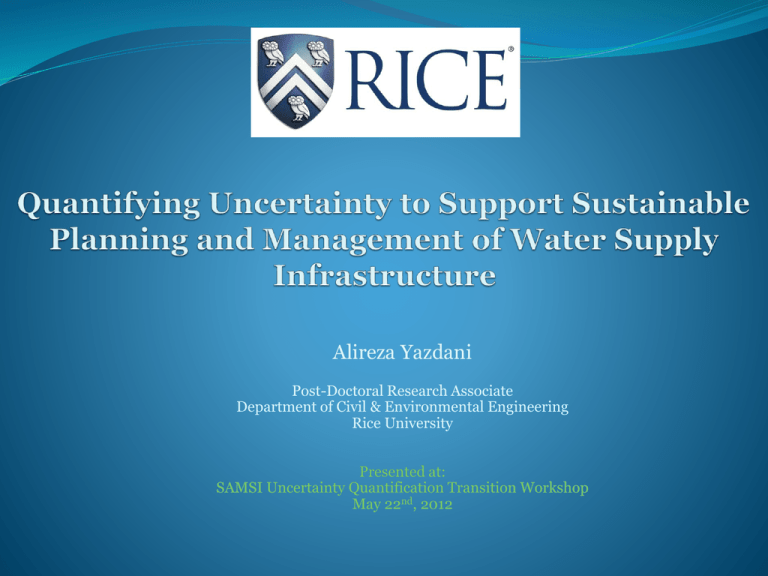
Alireza Yazdani
Post-Doctoral Research Associate
Department of Civil & Environmental Engineering
Rice University
Presented at:
SAMSI Uncertainty Quantification Transition Workshop
May 22nd, 2012
NETWORK TOPOLOGY
UNCERTAINTY QUANTIFICATION
SYSTEM PERFORMANCE EVALUATION
SUSTAINABLE WATER SUPPLY MANAGEMENT
2
•
Water Distribution Systems (WDS) are
large complex networks of multiple
interdependent nodes (e.g. reservoirs,
fittings, fire hydrants) joined by links
(e.g. pipes, valves, pumps).
•
Main system components:
•
•
•
•
•
Source
Treatment
Transmission
Storage
Distribution
A hypothetical network representation
3
The US Water infrastructure is old, fragile and inadequate in meeting the
increasing demand for water.
•
•
Last year’s Texas drought resulted in a spike in water main breaks (CBS local, Aug 2011).
•
Existing centralized networks, suffer from high water age, bio-film growth,
pressure loss and high energy consumption.
•
There is currently an underinvestment (~ $108.6 Billion).
Source: (EPA, 2006 Committee on Public Water Supply Distribution
Systems: Assessing and Reducing Risks, National Research
Council, and 2009 Report Card for America’s Infrastructure)
4
2009 ASCE Report Card for America’s
Infrastructure
Aviation
D
Bridges
C
Dams
D
Drinking Water
D-
Energy
D+
Hazardous Waste
D
Inland Waterways
D-
Levees
D-
Public Parks & Recreation
C-
Rail
C-
Roads
D-
School
D
Solid Waste
C+
Transit
D
Wastewater
D-
America's Infrastructure
G.P.A. = D
A = Exceptional
B = Good
C = Mediocre
D = Poor
F = Failing
5
• A sustainable Water Supply System is one that supplies
anticipated demands over a sensible time horizon without
degradation of the source of the supply or other element’s of
the system’s environment.*
• Criteria:
•
Achieving sustainability requires integrated
Reliability:
•analysis
adequate
flow
and pressure,ofavailability
of the
and
optimization
performance
physical
components
criteria
while
dealing with uncertainties in
•
Water Quality:
• Acceptable water age and chemical contents
•
Efficiency:
• leakage management, operational efficiency and
environmental impacts
the data/model/natural environment
* Water Distribution Systems (2011), D. Savic, J. Banyard (Eds.), ICE Press.
6
Reservoir and treatment facilities
Adequacy (quality/quantity):
How does water taste there?
Is the pressure sufficient?
Reliability:
what if these pipes break
together?!
Efficiency:
what is the cost/impacts
of getting water here?
A slightly reconfigured EPANET representation of Colorado Springs WDS
7
• Reducible ( epistemic) uncertainty: Resulting from a lack of information in model
about the system, typically reduced through inspection, measurement or improving the
analogy between the abstract model and real system
• Irreducible (aleatoric) uncertainty: Natural randomness in a process, usually
described by probabilistic approaches
Not to be absolutely certain is, I think, one of the
essential things in rationality.
Bertrand Russell
Image taken from: S. Fox (2011), Factors in ontological uncertainty related
to ICT innovations, I. J. Manag. Proj. Busin, 4 (1), 137-149.
8
•
•Model
Determining
the pipe
size, tank diameter,
network
topology
at design
(e): inability
to represent
true physics
of the
system
and itsstage
behaviour
•
•Data
Placement
of sensors/control
to monitor water quality
(e): measurement
error, valves
inconsistent/inaccurate/inadequate
data
•
•
•
Prediction of the physical components failure rates and evaluating failure consequences
Operation (e): related to the system construction, design, equipments, deterioration,
•maintenance
Estimating water weekly/monthly/yearly water demand to support normal/peak
consumption
(a): the
unpredictability
of nature and its impacts
on resources
the system
•Natural
Assessing
impacts of climate/demographical
changes on
9
WDS Performance is largely affected by network topology
Uncertainty in system performance due to the unknown/unpredictable parameters may be
reduced through studying topology.
Source unavailable
Reservoir
Reservoir
Pipe Break/Contaminant
Ingress
Tank
•
•
•
Reliability: how often the system fails (in quantity or quality terms).
Vulnerability: how serious the consequences of the failure may be.
Resiliency: how quickly the system recovers from failure.
10
• Centralized treatment/operation
•
water quality deterioration
•
cost of wastewater collection
•
high energy loss
• Decentralized treatment
•
shorter pipe lengths
•
improved water quality?
•
more efficient?
Image from D. Kang, K. Lansey, Scenario-based Robust Optimization of Regional
11
Water/Wastewater Infrastructure,doi:10.1061/(ASCE)WR.1943-5452.0000236
Metric
Spectral Graph Theory
Proxy for
•Fault-tolerance (design)
•Rate of contaminant spread
Centrality measures
•Component criticality analysis
•Network vulnerability to random
failures/targeted attacks
Path length/distances
•Friction losses
•Design/Operation Cost
•Access between source and nodes
•Water residence time
Loops
•Redundancy
• Reliability
12
•
Random networks:
•
•
•
•
Small worlds:
•
•
•
Random degree distribution (equal connectivity likelihood)
Network equally vulnerable to failures/attacks (typical nodes)
Examples: spatial networks (no hubs, large diameter)
Gaussian or exponential degree distribution
Large networks with low path lengths and high clustering
Scale free networks:
•
•
•
Scale-free networks/power law degree distribution
Many low degree nodes with very few highly connected hubs
Robust against random component failures yet fragile under
targeted attacks on the hubs
13
Image: Albert, Barabasi and Bonabeau, (2003), Scale-free Networks, Scientific American, 288, 50-59.
14
Colorado Springs (CS), USA
City of Houston (COH), USA
Richmond Yorkshire Water (RYW), UK
15
Colorado
Springs
City of
Houston
Richmond
Nodes
1786
3926
872
Links
1994
5801
957
Total pipe length (km)
117.01
3166.15
75.61
Average pipe length (m)
187.12
574.2
633.09
2.43 e-4
2.26 e-4
6.09 e-5
Average node degree
2.23
2.96
2.19
Average path length
27.23
25.94
51.44
Central-point
dominance
0.42
0.34
0.56
Critical ratio of random
breakdown
0.57
0.42
0.32
Graph diameter
69
72
135
Maximum node degree
4
9
4
Meshedness coefficient
0.0586
0.239
0.0495
Node (link) connectivity
1 (1)
1 (1)
1 (1)
Topological efficiency
5.2 %
2.4 %
3.4 %
Metric
Algebraic connectivity
16
W1=1
i
W1=0.5
W2=0.5
i
W3=0.3
W3=0.3
i
W3=0.3
W3=0.3
i
W3=0.6
d=0.4
W3=0.2
Demand-adjusted entropic degree (DAED)* combines topology and physics by
incorporating the number of links attached to a node, the capacity of the link
connections and the way they are distributed while taking into account the demand
for water at each node.
* A. Yazdani, P. Jeffrey (2012), Water Resour. Res., doi:10.1029/2012WR011897, in press
17
Node ID
Node ID
900
800
0
700
0
600
100
500
1
400
200
300
300
200
2
Node Degree
400
100
3
DAED
4
80
2
60
0
DAED
4
0
1800
1600
1400
1200
1000
800
600
400
200
0
Node Degree
CS
RYW
500
120
3
100
1
40
20
0
18
RYW
CS
Colorado Springs’ top three most
important nodes
Richmond’s top three most important
nodes
ID
Degree
DAED
Normalized DAED
ID
Degree
DAED
Normalized
DAED
144
4
542.28
1
153
2
94.37
1
1229
3
354.36
0.65
20
2
75.59
0.80
1373
3
192.27
0.36
219
2
64.38
0.68
19
100%
Richmond
80%
Colorado Springs
40%
20%
1.0
0.9
0.8
0.7
0.6
0.5
0.4
0.3
0.2
0.1
0%
0.0
Pr { > f }
60%
Normalized DAED
20
•
The analysis of WDS topology:
Reduces model uncertainty and offers a computationally inexpensive and less datadependent simplified approach
Helps quantifying vaguely understood qualities such as redundancy, optimalconnectivity and fault-tolerance
Supports development and comparison of the alternative design and operation (e.g.
Decentralized) scenarios
•
The UQ via studying interactions of system topology and performance (hydraulic
reliability, energy use, water quality) provides theoretical support for finding sustainable
solutions
for
water
infrastructure
systems
planning
and
management
(rehabilitation/design/expansion problems).
•
Due to the WDS specifications, data and model uncertainties, and hydraulic complexities,
advanced UQ techniques (e.g. spectral methods, multiple regression and survival analysis
and non-parametric statistics) have a special place in the realistic analysis of WDS
vulnerability/sustainability.
21
•
Performance analysis and comparison
of the centralized, decentralized and
hybrid layouts in terms of water
quantity and quality
•
Analysis of historical failure data to
develop component/system failure rate
models serving reliability analysis
•
Investigating the role of network
topology (in the presence or absence of
shut off valves) in facilitating mass
transport/preventing the spread of
contaminants within the system
validated by the EPANET models
22
•
Rice University Shell Centre for Sustainability
•
SAMSI for the travel support
•
Dr. Leonardo Duenas-Osorio and Dr. Qilin Li of Rice University
Civil and Environmental Engineering
23
